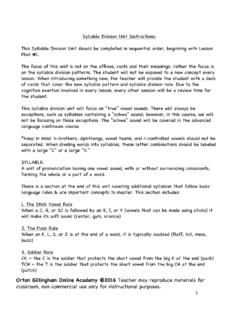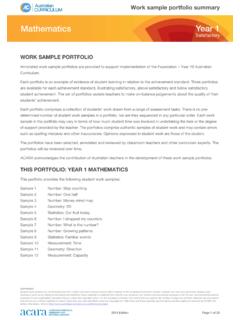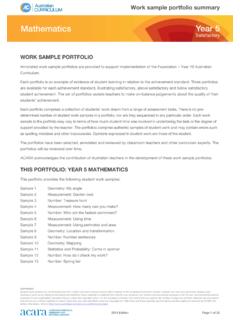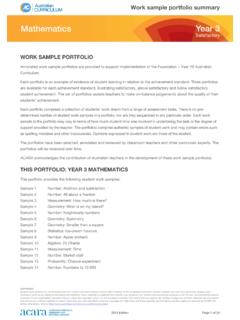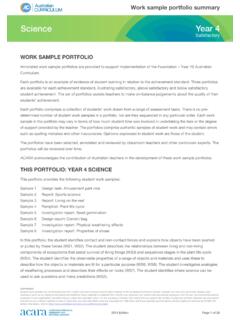Transcription of LEARNING OBJECTIVES TEACHING ACTIVITIES
1 LEARNING OBJECTIVES . &. TEACHING ACTIVITIES . PRE-EMERGENT LITERACY LEVEL NOVICE LITERACY LEVEL. LISTENING/SPEAKING LISTENING/SPEAKING. Elementary Elementary Middle School/Junior High Middle School/Junior High High School High School READING/PRINT AWARENESS READING/PRINT AWARENESS. Elementary Elementary Middle School/Junior High Middle School/Junior High High School High School WRITING WRITING. Elementary Elementary Middle School/Junior High Middle School/Junior High High School High School EMERGENT LITERACY LEVEL EXPERIMENTING LITERACY LEVEL. LISTENING/SPEAKING LISTENING/SPEAKING. Elementary Elementary Middle School/Junior High Middle School/Junior High High School High School READING/PRINT AWARENESS READING/PRINT AWARENESS. Elementary Elementary Middle School/Junior High Middle School/Junior High High School High School WRITING WRITING. Elementary Elementary Middle School/Junior High Middle School/Junior High High School High School CONVENTIONAL LITERACY LEVEL.
2 LISTENING/SPEAKING. Elementary Middle School/Junior High High School READING/PRINT AWARENESS. Elementary Middle School/Junior High High School WRITING. Elementary Middle School/Junior High High School iv Pre-Emergent Literacy Level Students: typically communicate in one to two-word verbal or picture symbol utterances to make simple requests ( , for assistance, objects, and ACTIVITIES ). attend to completion of short ACTIVITIES (listen to a story, play a game, etc.). understand and respond appropriately to some routine questions. exhibit waiting and turn-taking. attend more to pictures and the reader than to the print when stories are read aloud. demonstrate minimal art/writing attempts. identify familiar pictures and objects by name. identify parts of a whole ( , parts of a book, body parts, etc.). copy melodic speech patterns. LEARNING OBJECTIVES : Listening/Speaking The student will: 1. listen with increasing attention.
3 2. understand and follow simple, concrete commands with visual prompts. 3. listen to simple stories and request familiar stories. 4. show steady increase in listening and speaking vocabulary in everyday conversation. 5. listen with increased wattention to information, rhymes, songs, conversations, and stories. LEARNING OBJECTIVES : Listening/Speaking The student will: 1. examine and label pictures in books and point to pictures to request that adult name te picture. 2. repeat part of text on a page immediately after it has been read aloud by an adult. 3. recognize favorite books by the cover. 4. frequently request the re-reading of books. LEARNING OBJECTIVES : Listening/Speaking The student will: 1. randomly draw and scribble. 2. use a variety of writing and art tools to create a finished product. v PRE-EMERGENT. LISTENING/SPEAKING. vi ( ) The student listens attentively and engages in a variety of oral language experiences.
4 Area: Pre-Emergent Listening/Speaking OBJECTIVE TEACHING ACTIVITIES . 1. The student will listen with increasing 1. Students will interact with teacher in small attention. groups. Play games such as finger plays, Simon Says, Red-Light Green-Light. Read and re-read stories with repeated lines. Dictate stories about classroom experiences. Increase duration of group story time as listening skills develop. 2. Provide a listening center with stories on tape. Give all students an opportunity to listen to stories daily. Adaptations: RESOURCES/MATERIALS. Large picture books with one or two objects Various children's books on each page ( , picture of ball and word Big books ball ). Flannel board stories Simple voice output devices programmed Pictures to sequence with repeated lines from stories Pre-Emergent E-1. Pre-Kindergarten Curriculum Guidelines: The student is able to comprehend what he/she hears in conversations and in stories read aloud.
5 Area: Pre-Emergent Listening/Speaking OBJECTIVE TEACHING ACTIVITIES . 2. The student will understand and follow 1. Given a picture symbol, student will match simple, concrete commands with visual picture to concrete object. prompts. 2. When presented a picture of an activity (walking, jumping, yawning, etc.), student will imitate activity. 3. Sing Itsy Bitsy Spider or other finger play. Students imitate teacher's hand movements. 4. Student will learn to follow simple daily routine instructions ( , take off your coat, sit down, get your cup, etc.) Use picture or object symbol cues when needed. Adaptations: RESOURCES/MATERIALS. Object/character props on Popsicle sticks /. Magazine pictures showing actions tongue depressors for students (as needed). Flannel board/magnetic board Picture or object symbols Pictures for Itsy Bitsy Spider . Picture symbols and associated objects Pre-Emergent E-2. Pre-Kindergarten Curriculum Guidelines: The student communicates by putting thoughts, feelings and requests into words, signs or symbols.
6 Area: Pre-Emergent Listening/Speaking OBJECTIVE TEACHING ACTIVITIES . 3. The student will listen to simple stories and 1. Teacher and students will engage in reading request familiar stories. Big books, poems, charts, and storybooks on tape. 2. Students can request stories by name or main character. For students who are non- verbal, teacher can reproduce a picture of a story character from a specific book ( , Arthur or Clifford) or reproduce book jacket or title page, as needed. Maintain a file for students to make selections. Adaptations: RESOURCES/MATERIALS. Plastic/plush character to represent book Big books character. Storybooks Program multi-location voice output Storybooks on tape devices with titles of familiar books. Symbols/pictures to represent book titles Pre-Emergent E-3. Pre-Kindergarten Curriculum Guidelines: The student develops new concepts, acquires new words, and increasingly refines his/her understanding of words that he/she already knows.
7 Area: Pre-Emergent Listening/Speaking OBJECTIVE TEACHING ACTIVITIES . 4. The student will show steady increase in 1. Provide opportunities for dramatic play. listening and speaking vocabulary in The student will practice conversation everyday conversation. skills, taking turns, providing information, and making requests when role-playing pretend ACTIVITIES such as dress-up, using the telephone, playing store, etc. 2. Provide Community Based Instruction having students practice ordering, making choices, requesting specific items, etc. Adaptations: RESOURCES/MATERIALS. Simple voice output devices and/or picture Telephones symbols for non-verbal students to show Props for role-playing understanding, comment, ask questions, etc. Pre-Emergent E-4. ( ) The student listens attentively and engages in a variety of oral language experiences. Area: Pre-Emergent Listening/Speaking OBJECTIVE TEACHING ACTIVITIES . 5. The student will listen with increased 1.
8 Share the story Old McDonald Had a attention to information, rhymes, songs, Farm . Introduce farm vocabulary and conversations and stories. animal noises. Have students sit in a circle. Give each student either an animal picture or plastic animal in correct sequence of the song. As the song is sung, each student gets to sing out his/her animal noise. 2. Students will learn to recite the Pledge of Allegiance with teacher prompts and visual cues. Writing with Symbols 2000 (Mayer- Johnson) may be used to write and add symbols to the Pledge of Allegiance. 3. Student will take attendance/lunch count to the office or cafeteria. Student will greet the person they are addressing, tell what they are bringing, tell who sent them, and give a proper salutation upon leaving. Adaptations: RESOURCES/MATERIALS. Use recordable picture frames or other Animal Pictures simple voice output devices with animal Plastic animals sounds and pictures for student with Simple speech output devices physical/communication limitations.
9 Use recordable voice output devices to allow students to say the Pledge of Allegiance. Pre-Emergent E-5. ( ) The student listens attentively and engages in a variety of oral language experiences. Area: Pre-Emergent Listening/Speaking OBJECTIVE TEACHING ACTIVITIES . 1. The student will listen with increasing 1. Seat students in a circle. Whisper attention. something to student on the left. That student then whispers something to the student on his/her left, and so on. The whispering continues, student to student, in clockwise order until it reaches the last student, who says out loud what he/she has heard. 2. Prior to a story being read aloud, teacher assigns a word for each child to listen for, or a sound for them to identify. When the word is heard, the student indicates hearing the word in some manner (such as raising his/her hand, making a sound, saying That's my word , etc.). Note: This game is difficult for a variety of reasons.
10 The youngest students may need preliminary practice in passing to the left. This can be done by asking students to tap each other in turn or to pass an object from one to the next. To make the game easier, put students in small groups of five or less. Begin with single words, then phrases, and then full sentences as students develop skills. Since auditory information is not always processed immediately. Providing visual information through pointing to specific relationships in the pictures, signs, drawings, may be needed to encourage attention. Pre-Emergent M-1. Area: Pre-Emergent Listening/Speaking OBJECTIVE TEACHING ACTIVITIES . (Continued). Adaptations: RESOURCES/MATERIALS. Activity #1: Program the message into a Phonemic Awareness in Young Children single message voice output device. Attach (Adams, 1998) earphones to the device for the second student in the circle to wear. The student using the voice output device should be the first one to speak the message to the second student in the circle.


